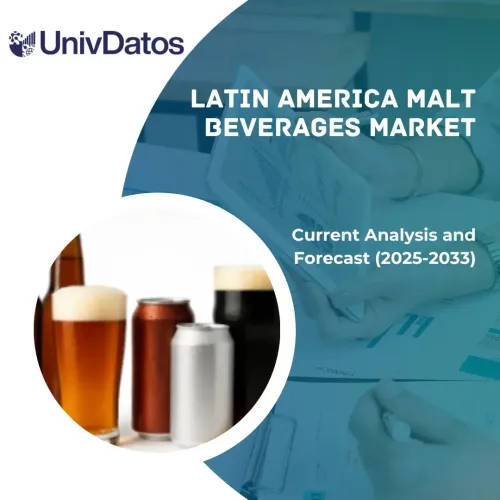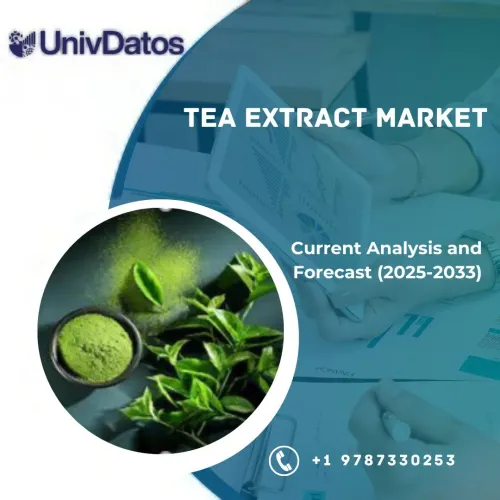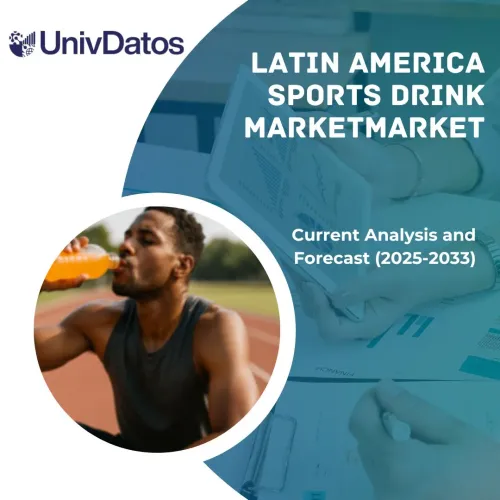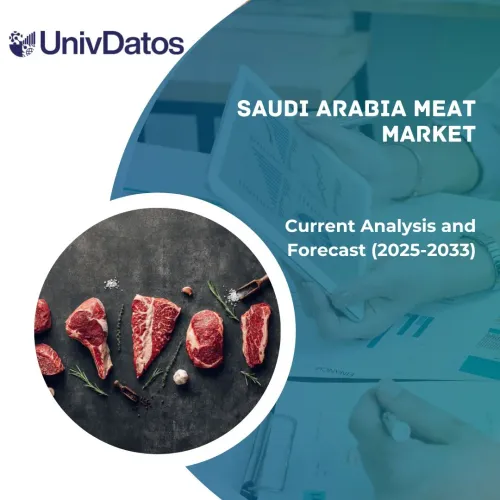- Home
- About Us
- Industry
- Services
- Reading
- Contact Us
Infant Formula Ingredients Market: Current Analysis and Forecast (2023-2030)
Type (Carbohydrates, Oil & Fats, Protein, Vitamin, Minerals, Prebiotics); Form (Powder, Liquid, Semi Liquid); Application (Growing Milk, Standard Infant, Follow On Formula, Specialty Formula) and Region/Country
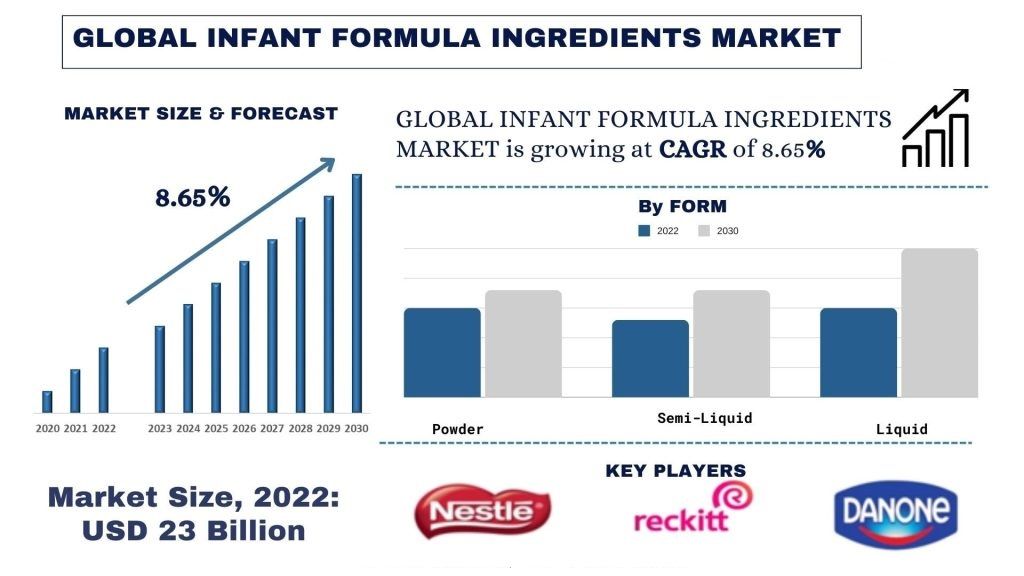
Infant Formula Ingredients Market Size and Forecast
The Infant Formula Ingredients Market was valued at USD 23 Billion in 2022 and is expected to grow at a strong CAGR of around 8.6% during the forecast period (2023-2030) owing to increased health awareness for infants.
Infant Formula Ingredients Market Analysis
The Infant Formula Ingredients Market plays a crucial role in providing essential nutrition to infants who are unable to be breastfed or require supplementary feeding. While breast milk is considered the gold standard for infant nutrition, formula serves as a viable alternative for mothers who are unable to breastfeed or choose not to do so. As a vital component of infant formula production, these ingredients undergo rigorous testing and quality control to ensure they meet the nutritional needs and safety standards for infant consumption. With a growing global population, changing dietary patterns, and increasing awareness of infant health and nutrition, the infant formula ingredients market is experiencing significant growth and innovation. For Instance: In January 2021, BLC or Bunge Loders Croklaan launched a new premium lipid ingredient, especially for baby formula. The value addition for the same is to allow the manufacturers to get a notch closer to the actual gold standard breast milk. The solution is called Betapol Select which would allow adjusting the regional differences. Earlier, the product was lauded and based on Chinese baby’s requirements.
Furthermore, In August 2020, Danone Nutricia – a brand of Danone SA launched a new product, Karicare Toddler with a new product innovation made with pure New Zealand sheep milk.
Some of the major players operating in the market: Abbott, Arla Foods Amba, Campbell Soups, Dana Dairy Group Ltd, Danone, D-Signstore, HIPP GmbH & Co. Vertrieb KG, Reckitt Benckiser, Nestle, The Hain Celestial Group
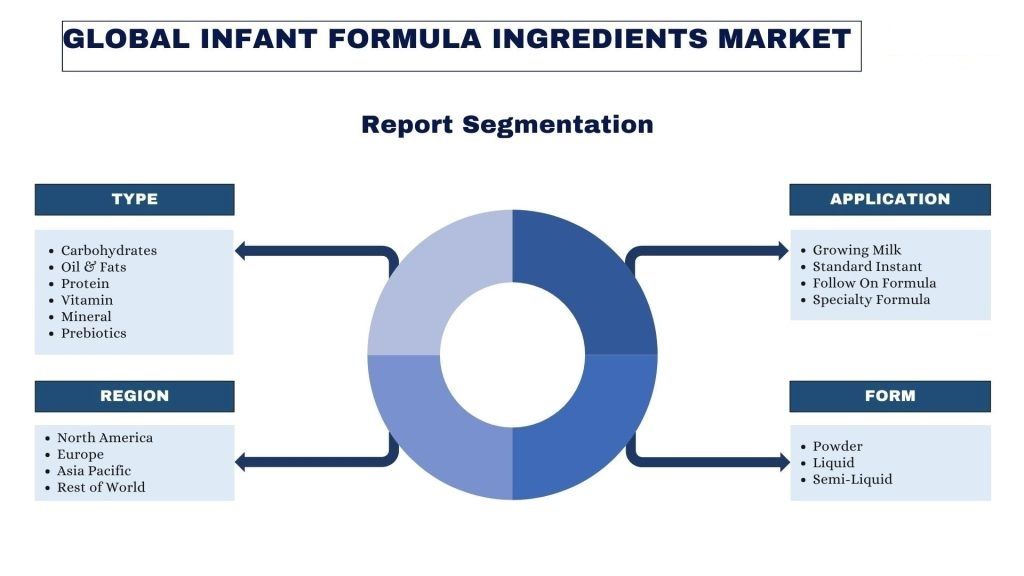
Infant Formula Ingredients Market Trends
“Amongst type, the carbohydrates category to held dominant share of the market in 2022”
Based on the type, the market is segmented into carbohydrates, oil & fats, protein, vitamin, minerals, prebiotics. carbohydrates segment held a dominant share of the market in 2022 are anticipated to grow with high CAGR during the forthcoming period. Due to the fact that carbohydrates in infant formula come in various forms, such as lactose, starch, and maltodextrin, catering to different nutritional and developmental needs of infants. For Instance: In 2023, According to Nutricia, a Danone brand, there is increasing evidence that BMI in early life is an indicator of the development of body weight into adulthood also, Carbohydrates like oligosaccharides, which are naturally present in breast milk, act as prebiotics, feeding the good bacteria and helping them thrive and a new study published in the American Journal of Clinical Nutrition shows that the long-term health effects of a concept baby formula with lipid droplets are closer to those of breast milk.
“Amongst Form, the powder segment to grow with high CAGR during the forecast period”
On the basis of form, the market is categorized into powder, liquid, and semi-liquid. The powder segment is anticipated to grow with high CAGR during the forthcoming period. Powdered infant formula is widely favored for its convenience and accessibility. Unlike ready-to-feed or liquid concentrate formulas, powdered formula is shelf-stable and lightweight, making it easy to store and transport. This convenience factor is particularly beneficial for parents on the go, as powdered formula can be easily prepared by mixing the appropriate amount of powder with water when needed, providing a quick and hassle-free feeding solution. In addition to its convenience, powdered infant formula is often more affordable compared to other forms.
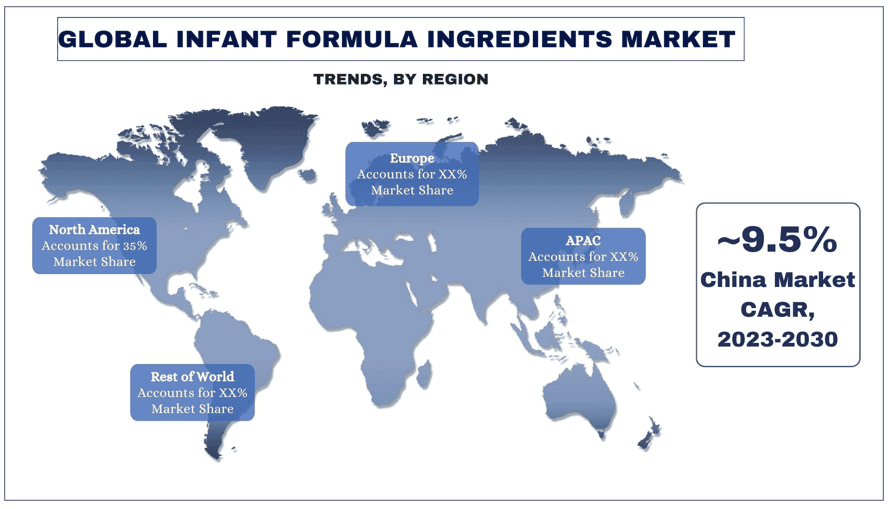
“Amongst Application, the Growing Milk formula to grow with significant CAGR during the forecast period”
On the basis of application, the market is segmented into Growing Milk, Standard Infant, Follow On Formula, Specialty Formula. The Standard infant formula (0-6 months) had the largest share in 2022 due to its capability to replace nursing feed for the new born but, the Growing Milk (12 months and older) is said to lead the CAGR for the forecasted period as these formulas contain higher levels of essential vitamins and minerals, such as calcium, iron, and vitamin D, which are crucial for bone health, cognitive development, and immune function. Parents are increasingly turning to growing milk formula as a convenient and reliable way to ensure that their growing babies receive the necessary nutrients for optimal growth and development during this critical stage of life.
“APAC to grow with high CAGR during forthcoming”
The Asia Pacific region has witnessed significant growth in the Infant Formula Ingredients market. Consumers in this region have started to embrace the changing demographics, evolving consumer preferences and increasing disposable incomes, leading to a surge in infant formula ingredients market. One of the key factors driving the growth of the Infant Formula Ingredients market in the region is the increase in the shift of demographics. Asia Pacific region’s ascent in the infant formula market is its rapidly changing demographics. Countries within the region, such as China, India, and Indonesia, boast large populations with a rising middle class. With urbanization and economic development, more women are entering the workforce, leading to an increased demand for convenient and nutritionally balanced infant formula products. For Instance: In May, 2022 Meji Dairies Corp.’s re-entry into Thailand’s toddler formula market with milk powder cubes to overcome time wastage and powder spillage.
Infant Formula Ingredients Market Report Coverage
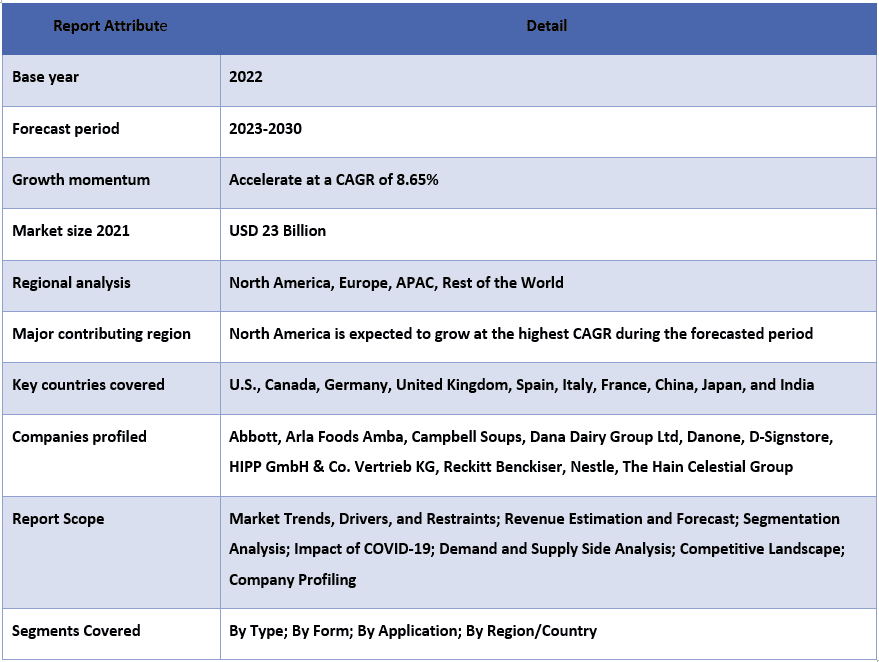
Reasons to buy this report:
- The study includes market sizing and forecasting analysis validated by authenticated key industry experts.
- The report presents a quick review of overall industry performance at one glance.
- The report covers an in-depth analysis of prominent industry peers with a primary focus on key business financials, product portfolios, expansion strategies, and recent developments.
- Detailed examination of drivers, restraints, key trends, and opportunities prevailing in the industry.
- The study comprehensively covers the market across different segments.
- Deep dive regional level analysis of the industry.
Customization Options:
The Global Infant Formula Ingredients Market can further be customized as per the requirement or any other market segment. Besides this, UMI understands that you may have your own business needs, hence feel free to connect with us to get a report that completely suits your requirements.
Table of Content
Research Methodology for the Infant Formula Ingredients Market Analysis (2023-2030)
Analyzing the historical market, estimating the current market, and forecasting the future market of the global Infant Formula Ingredients market were the three major steps undertaken to create and analyze the adoption of Infant Formula Ingredients in major regions globally. Exhaustive secondary research was conducted to collect the historical market numbers and estimate the current market size. Secondly, to validate these insights, numerous findings and assumptions were taken into consideration. Moreover, exhaustive primary interviews were also conducted, with industry experts across the value chain of the global Infant Formula Ingredients market. Post assumption and validation of market numbers through primary interviews, we employed a top-down/bottom-up approach to forecasting the complete market size. Thereafter, market breakdown and data triangulation methods were adopted to estimate and analyze the market size of segments and sub-segments of the industry pertains to. Detailed methodology is explained below:
Analysis of Historical Market Size
Step 1: In-Depth Study of Secondary Sources:
Detail secondary study was conducted to obtain the historical market size of the Infant Formula Ingredients market through company internal sources such as annual reports & financial statements, performance presentations, press releases, etc., and external sources including journals, news & articles, government publications, competitor publications, sector reports, third-party database, and other credible publications.
Step 2: Market Segmentation:
After obtaining the historical market size of the Infant Formula Ingredients market, we conducted a detailed secondary analysis to gather historical market insights and share for different segments & sub-segments for major regions. Major segments are included in the report as type, form, and application. Further country-level analyses were conducted to evaluate the overall adoption of testing models in that region.
Step 3: Factor Analysis:
After acquiring the historical market size of different segments and sub-segments, we conducted a detailed factor analysis to estimate the current market size of the Infant Formula Ingredients market. Further, we conducted factor analysis using dependent and independent variables such type, form, and application of the Infant Formula Ingredients market. A thorough analysis was conducted for demand and supply-side scenarios considering top partnerships, mergers and acquisitions, business expansion, and product launches in the Infant Formula Ingredients market sector across the globe.
Current Market Size Estimate & Forecast
Current Market Sizing: Based on actionable insights from the above 3 steps, we arrived at the current market size, key players in the global Infant Formula Ingredients market, and market shares of the segments. All the required percentage shares split, and market breakdowns were determined using the above-mentioned secondary approach and were verified through primary interviews.
Estimation & Forecasting: For market estimation and forecast, weights were assigned to different factors including drivers & trends, restraints, and opportunities available for the stakeholders. After analyzing these factors, relevant forecasting techniques i.e., the top-down/bottom-up approach were applied to arrive at the market forecast for 2030 for different segments and sub-segments across the major markets globally. The research methodology adopted to estimate the market size encompasses:
- The industry’s market size, in terms of revenue (USD) and the adoption rate of the Infant Formula Ingredients market across the major markets domestically
- All percentage shares, splits, and breakdowns of market segments and sub-segments
- Key players in the global Infant Formula Ingredients market in terms of products offered. Also, the growth strategies adopted by these players to compete in the fast-growing market
Market Size and Share Validation
Primary Research: In-depth interviews were conducted with the Key Opinion Leaders (KOLs) including Top Level Executives (CXO/VPs, Sales Head, Marketing Head, Operational Head, Regional Head, Country Head, etc.) across major regions. Primary research findings were then summarized, and statistical analysis was performed to prove the stated hypothesis. Inputs from primary research were consolidated with secondary findings, hence turning information into actionable insights.
Split of Primary Participants in Different Regions
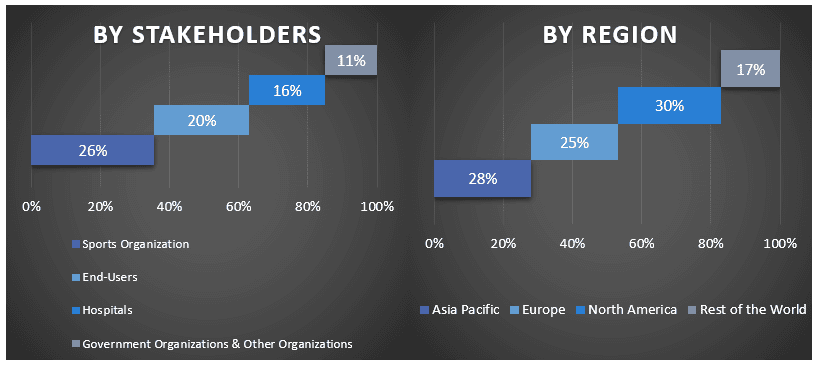
Market Engineering
The data triangulation technique was employed to complete the overall market estimation and to arrive at precise statistical numbers for each segment and sub-segment of the global Infant Formula Ingredients market. data was split into several segments & sub-segments post studying various parameters and trends in the areas of the type, form, and application in the global Infant Formula Ingredients market.
The main objective of the global infant formula ingredients Market Study
The current & future market trends of the global infant formula ingredients market were pinpointed in the study. Investors can gain strategic insights to base their discretion for investments on the qualitative and quantitative analysis performed in the study. Current and future market trends determined the overall attractiveness of the market at a regional level, providing a platform for the industrial participant to exploit the untapped market to benefit from a first-mover advantage. Other quantitative goals of the studies include:
- Analyze the current and forecast market size of the Infant Formula Ingredients market in terms of value (USD). Also, analyze the current and forecast market size of different segments and sub-segments
- Segments in the study include areas of the type, form, and application.
- Define and analysis of the regulatory framework for the Infant Formula Ingredients industry
- Analyze the value chain involved with the presence of various intermediaries, along with analyzing customer and competitor behaviors of the industry
- Analyze the current and forecast market size of the Infant Formula Ingredients market for the major region
- Major countries of regions studied in the report include Asia Pacific, Europe, North America, and the Rest of the World
- Company profiles of the Infant Formula Ingredients market and the growth strategies adopted by the market players to sustain in the fast-growing market
- Deep dive regional level analysis of the industry
Frequently Asked Questions FAQs
Q1: What is the current market size and growth potential of the global Infant Formula Ingredients market?
Q2: What are the driving factors for the growth of the global Infant Formula Ingredients Market?
Q3: Which segment has the largest share of the global Infant Formula Ingredients market by Type?
Q4: What are the emerging technologies and trends in the global Infant Formula Ingredients market?
Q5: Which region will dominate the global Infant Formula Ingredients market?
Q6: Who are the key players operating in the global Infant Formula Ingredients market?
Related Reports
Customers who bought this item also bought





